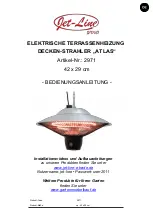
25
5. Ensure the drain hose is secured before and during the entire
flushing procedure. Flushing is performed with system water
pressure applied to the water heater.
6. Open the water heater drain valve to flush the storage tank.
7. Flush the water heater storage tank to remove sediment and
allow the water to flow until it runs clean.
8. Close the water heater drain valve when flushing is completed.
9. Remove the drain hose.
10. Fill water heater - see Filling The Water Heater in this manual.
11. Turn on electrical supply to place water heater back in operation.
12. Turn on the gas supply to the water heater at the Main Gas
Shutoff Valve.
13. Allow the water heater to complete several heating cycles to
ensure it is operating properly.
servIce
Before calling for repair service, read the “Start Up Conditions” and
“Operational Conditions” found in the “For Your Information” section
of this manual.
If a condition persists or you are uncertain about the operation of the
water heater contact a service agency. If you are not thoroughly familiar
with gas codes, your water heater, and safety practices, contact your
gas supplier or qualified installer to check the water heater.
Use the ”Leakage Checkpoints” guide to check a “Leaking”
water heater. Many suspected “Leakers” are not leaking tanks. Often
the source of the water can be found and corrected.
Read this manual first. Then before checking the water heater make
sure the gas supply has been turned “OFF”, and never turn the gas
“ON” before the tank is completely full of water.
Never use this water heater unless it is completely filled with water.
To prevent damage to the tank, the tank must be filled with water.
Water must flow from the hot water faucet before turning “ON” gas
to the water heater.
Read this manual first. Then before checking the water heater make
sure the gas supply has been turned “OFF”, and never turn the gas
“ON” before the tank is completely full of water.
Never use this water heater unless it is completely filled with water.
To prevent damage to the tank, the tank must be filled with water.
Water must flow from the hot water faucet before turning “ON” gas
to the water heater.
leaKaGe checKpoInts
A. Water at the draft hood is water vapor which has condensed out of
the combustion products. This is caused by a problem in the vent.
Contact the gas utility.
B. *Condensation may be seen on pipes in humid weather or pipe
connections may be leaking.
C. *The anode rod fitting may be leaking.
D. Small amounts of water from temperature-pressure relief valve may
be due to thermal expansion or high water pressure in your area.
E. *The temperature-pressure relief valve may be leaking at tank
fitting.
F. Water from a drain valve may be due to valve being slightly opened.
G. *The drain valve may be leaking at the tank fitting.
H. Combustion products contain water vapor which can condense on
the cooler surfaces of the tank. Droplets form and drip onto the
burner or run on the floor. This is common at the time of start-up
after installation and when incoming water is cold.
I. Water in the water heater bottom or on the floor may be from
condensation, loose connections, or the relief valve. DO NOT
replace the water heater until a full inspection of all possible water
sources is made and necessary corrective steps taken.
Leakage from other appliances, water lines, or ground seepage should
also be checked.
* To check where threaded portion enters tank, insert cotton swab
between jacket opening and fitting. If cotton is wet, follow “Draining”
instructions in the “Periodic Maintenance” section and then remove
fitting. Put pipe dope or teflon tape on the threads and replace.
Then follow “Filling the Water Heater” instructions in the “Installing
the New Water Heater” section.












































